By now, we’ve all heard of pay-per-click advertising, a strategy that enables you to reach out to your audience while still keeping an eye on your marketing budget. But how well are you actually managing your PPC approach, and is it really paying off according to the benchmarks of your industry?
First things first: What’s involved in PPC management?
PPC puts your ads in front of your target audience, on channels including social media and search engines.
We’ve all seen those ads that come up at the top of Google results.
In fact, they’re sometimes indiscernible from regular search results – 46% of users said they can’t tell the difference, according to Wordstream.
In any case, each time these ads are clicked, marketers pay a fee. However, they stand to make even more if this click results in customer engagement and conversion.
Therefore, PPC management involves the strategy, planning, messaging, analysis and budgeting that drives the PPC ad.
This can either be done by a company’s internal team or an outsourced expert from a content marketing agency.
A few key tasks involved with the actual management of PPC include:
- Keyword research: What long- and short-tail keywords and phrases should be included in the ad so that it reaches the target audience you’re aiming for? The person spearheading PPC management will do specific keyword research that maps to the content and context of the ad, the overarching services and business goals and the search terms and phrases customers are using.
- Channel research: PPC management also involves pinpointing the right channel on which to run the advertisement. As noted, PPC can take place on social media, search engines and other popular channels. However, the strategy manager must ascertain whether an ad on social media will have more or less impact on their audience than a paid ad on Google or Bing, for example.
- Competitive analysis: Examining and analyzing the competition is always a key play in marketing, no matter the initiative. This also goes for PPC – brands should take a look at the ads their competitors are running, the channels on which these live and, if possible, the marketing results these ads have yielded for other organizations. Analyzing the wins or failures of other companies can help you improve your PPC management and avoid repeating the mistakes of other businesses.
- Bidding: The PPC manager will also decide upon the bid amount the company will leverage to secure its click ad, according to identified search terms, audience preferences and their overarching marketing spend allocation.
- Campaign monitoring: Once the PPC ad messaging has been crafted, the channel chosen and the campaign launched, PPC managers must monitor the success and return on investment of the ad. This should come according to specific industry and marketing sector benchmarks, which we’ll take a closer look at later in this article. By leveraging those metrics, marketers can optimize their PPC content to align with their business goals, including essentials like increased conversions, boosted engagement and overall company growth.
- Optimization through A/B testing: PPC managers also use A/B testing to compare advertising content and landing page design. A/B testing is an important part of PPC management, and can help stakeholders identify the ideal messaging and imagery to support their search ad success and optimize the campaign.
Why is PPC management important: Setting up to achieve top goals
There are a few key reasons why in-depth management of your PPC campaigns is an important pursuit for your marketing team or outsourced agency partner.
ROI tracking
The first element to consider here is the actual performance and ROI of your PPC investment.
After all, you can’t just throw a PPC ad out there and let it run wild without any supervision – you have to check on the engagement, potential optimization opportunities and the critical results the ad is actually providing.
Simply running PPC advertising without proper management and optimization to support ROI is like paying for a billboard in a desolate part of town – basically, why bother?
Make your marketing dollars go further
One of the most attractive benefits of PPC campaigns is the fact that marketers only have to pay when potential customers actually engage.
This allows marketing teams to spread their spend even further.
However, just like PPC’s other potential advantages (i.e., increased conversions, engagement and, potentially, profits) campaigns need the right management to deliver on these benefits.
Capturing, applying and learning from audience insights
Any lack of management for PPC campaigns causes you and your marketing team to lose out on valuable audience insights and opportunities to better hone your messaging and campaigns.
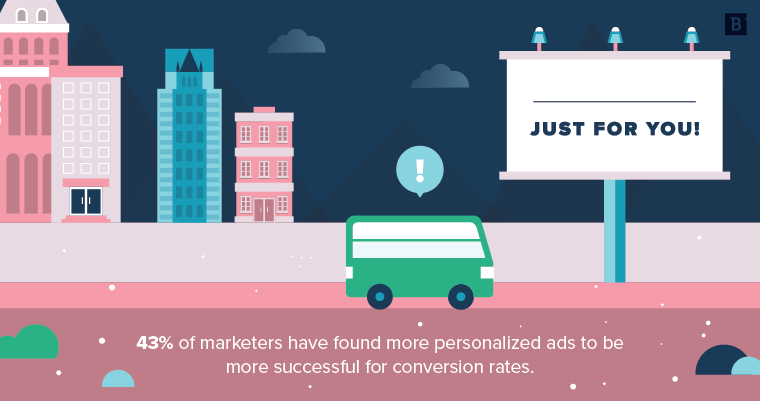
If you’re in the dark about how your PPC ad is performing, how many potential customers it’s brought to your site and how many of these resulted in conversions, how will you go about gauging the success of the campaign?
And how will you apply these lessons to your next marketing initiative?
PPC benchmarks: Money’s in the metrics
It’s not just about managing the creation of the PPC ad itself – you also need a keen focus on campaign monitoring and optimization.
If you’re just starting out and don’t yet have your own internal success metrics, you can use industry benchmarks to see how your PPC campaigns are going, compared to your market competition.
There are a few critical PPC metrics that you should track to get a good sense of your ROI and overall marketing results:
- Clicks: This one’s a no-brainer. Tracking clicks will also show how many potential customers have been led from the PPC ad to your landing page.
- Cost per click: In addition to the basic number of clicks, you and your team should also know your cost per click, or the price you pay each time a user engages with the ad. A typical PPC includes a preplanned budget drawn upon for each click. Once this budget is exhausted, the ad ceases to run until the budget is replenished. In order to discern just how much you need in your PPC budget bucket, campaign managers need to understand exactly how much each click costs, and how many potential customers they’d like to reach.
- Click-through rate: Building on the raw number of clicks and cost for each, marketing managers should track their click-through rate, which provides a percentage by dividing the number of clicks by the number of impressions. This percentage demonstrates how often users actually click on the ad when it’s displayed to them. A higher percentage means the ad is successful, and the majority of viewers who see the ad click on it. A low percentage, on the other hand, signals that it’s time to head back to the drawing board for more search term research and optimization.
- Conversion rate: When it comes to PPC, conversion doesn’t always equate to winning a sale, as it might be traditionally viewed. Instead, a successful conversion for pay-per-click advertising is when the user reaches the associated landing page and completes the action you want them to take on that page. For instance, the ad could lead to a landing page that offers gated, in-depth educational content in exchange for lead details like the user’s job title and email. We’ll get further into the importance of content in just a bit below. But it’s important to track the number of conversions in order to get a sense of how well the ad is paying off for your overarching ROI, how many leads it’s bringing in, or the other successful results according to the business goals identified to motivate the campaign.
Tracking metrics is key, but you should also have some context into where your benchmarks fall according to industry averages. WordStream recently released its updated Google Ads Industry Benchmarks results, which shows averages across top industries for PPC advertising. Let’s take a look at some examples:
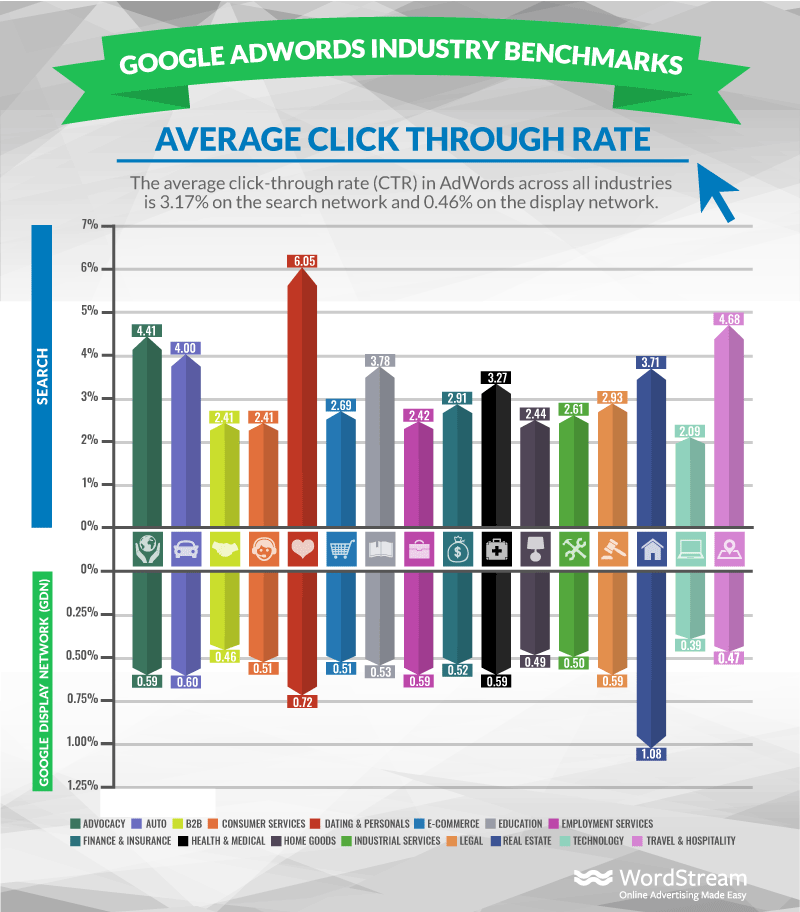
- The current average click-through rate across all industries is 3.17% on Google’s search network and 0.46% on the display network. Certain sectors are seeing notable click-through rates, including the Dating and Personals industry, which boasts over 6% click-through rate on search and 0.72% on the display network. The tech sector, on the other hand, experiences only 2.09% average click through for search and only 0.39% on display.
- Cost per click currently sits at an average of $2.69 for search and $0.63 for display. Notable exceptions include the consumer services and legal sectors, which are seeing $6.40 and $6.75 average CPC for search respectively. Additionally, the e-commerce sector has an average CPC of just $1.16 on search and $0.45 on the display network.
- The average conversion rate across all industries is currently 3.75% on search and 0.77% on the display network. Interestingly, we’d like to call out the Dating and Personals industry here as well, which is experiencing incredibly high conversions on search and the display network (9.64% and 3.34%). According to the report, sectors including the auto, consumer services, employment services, finance and accounting, and legal sectors are also seeing particularly high conversion rates, especially with search.
Where content comes into play
Until now, we haven’t touched much on actual content and how this fits into PPC. This certainly does not mean that content isn’t an integral part of your PPC initiative, or that you as the manager can overlook it.
Actually, the opposite is true.
Consider how PPC actually works:
- You research, create and optimize a click advertisement.
- This ad runs on social or search engines, depending upon the channel you’ve chosen that speaks most to your audience.
- Once a user clicks on the ad, they’re led from social media, Google or whathaveyou to …what?
What’s next?
The answer here is typically a piece of content, supported by an optimized landing page. This can include a gated asset (like a white paper, case study or eBook) that offers valuable, educational info or coverage on a topic in exchange for user details that your marketing team can use to pursue sales leads.
The PPC ad might also bring users to a blog that answers the question they’ve asked, or one of your company’s product or services landing pages that maps to the information they’re searching for.
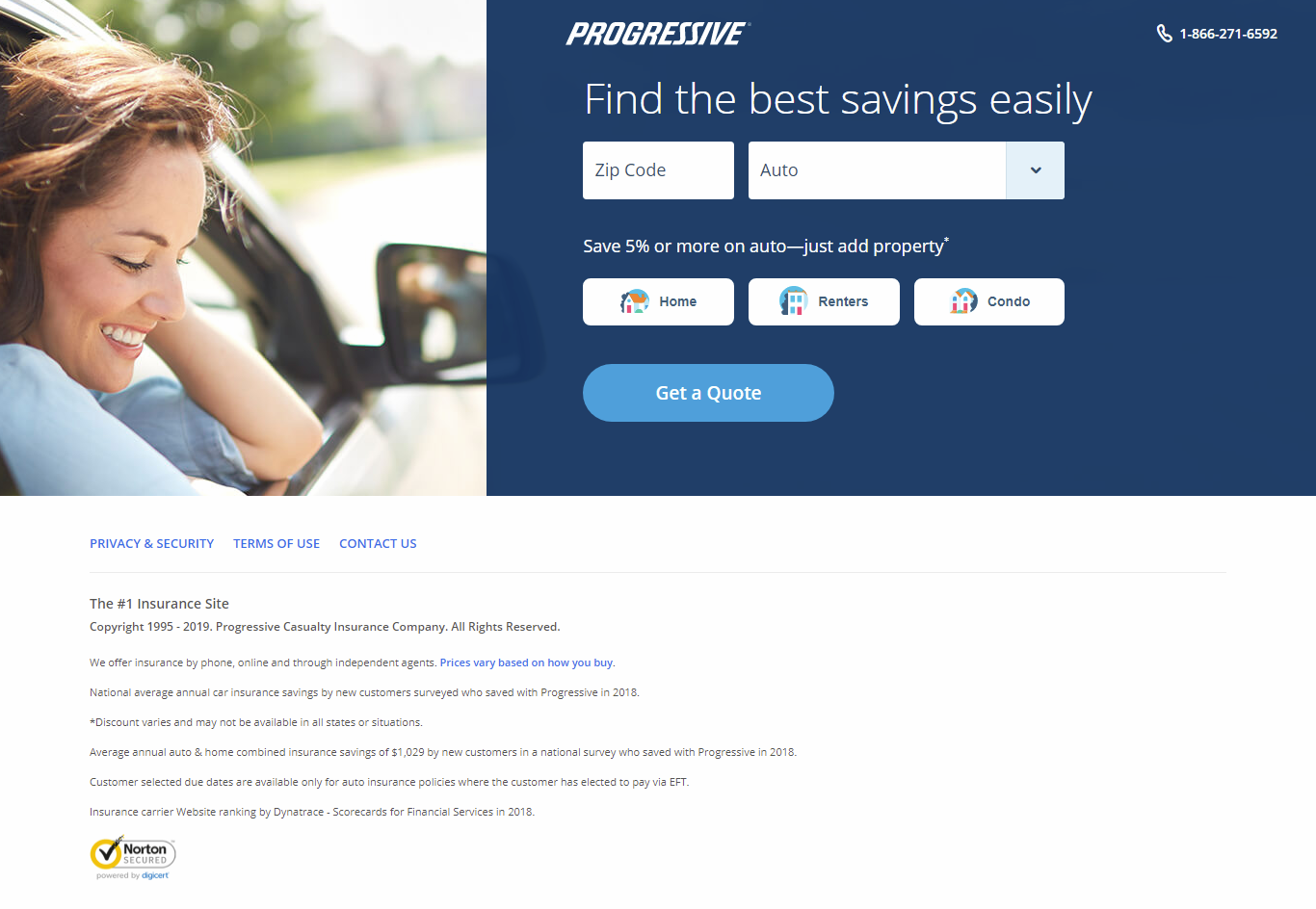
Whatever the case, the next landing point for your audience after clicking the ad should be content, supported by a conversion action.
You can use your target audience preferences and identified search terms for your PPC campaign to help decide upon the best piece of content and CTA to serve up through the ad.
It’s important to provide your audience something of value and a way to reach out or move on to the next step in the funnel.
Think: a blog that includes a visual, clickable CTA, a service landing page that enables users to live chat for more information or high-level gated content like a white paper or industry research report.
Grow your business: Tips and examples for PPC success
Consider the content
You should also consider the content of the ad itself. After all, while high placement on the results page can certainly help garner clicks and engagement, you have limited space and a small pool of words to get your message across and capture potential customers’ attention.
As I researched for this article, I came across this PPC example from HawkSEM:
Adwww.hawksem.com/ppc_management
PPC, SEO, Content & Social Media Marketing Experts – Contact Us For Your Fitting. No Hassle Flat Fees. No Setup Fees. Focused on Increasing ROI. Services: PPC, SEO, Content, Email, Social Media.
While it wasn’t exactly what I was looking for, it was sure effective at getting my attention. I definitely didn’t expect content mentioning a push-up bra to appear in results for a search on PPC marketing.
Use effective and relevant calls to action
You should also give some thought to the CTA you’ll use, both in the ad itself, and the landing page or other content where users are led.
According to WordStream analysis, certain CTA keywords prove more successful than others. Surprisingly, “click” is one of the least successful, whereas “get” and “buy” lead the pack.
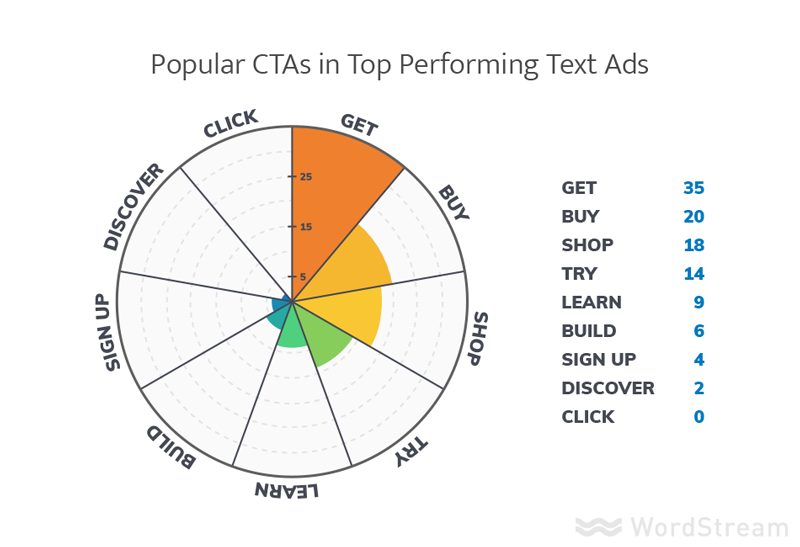
Cater to your audience
Another tip for our PPC marketers involves personalization.
Including keywords is helpful, but personalizing your ad content according to your target audience’s tastes and preferences is critical.
In fact, a survey from CMO Council showed that 43% of marketers have found more personalized ads to be more successful for conversion rates.
Take these results, for example:
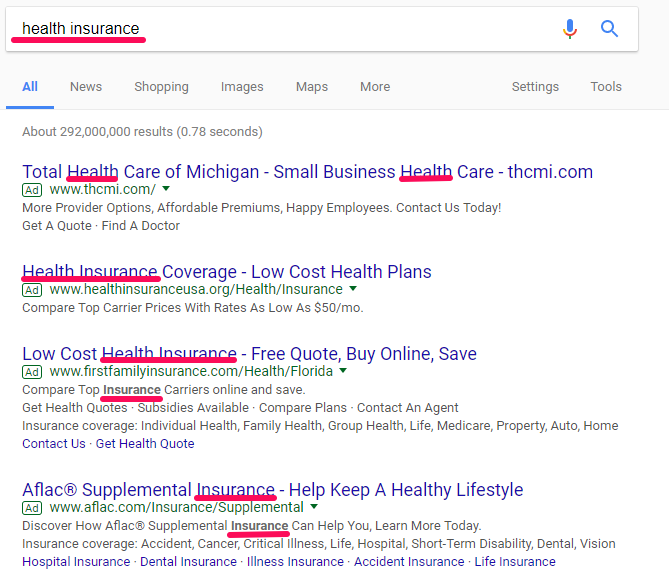
Including phrases like “small business health care” shows the company is targeting business clients. “Low cost health plans” can apply to a target audience that’s concerned about costs. The third result includes a little more meat to it, demonstrating that users can research information on an array of different plan types, and can compare their options online.
Depending upon the exact target audience each organization is trying to reach, the ad content is personalized accordingly.
Inform further with an ad extension
You can also consider beefing up your ad with an extension (i.e., additional info about your business) such as your sitelink, phone number, app download, customer review page or more. This provides users with an action to take directly from the ad itself, and can boost successful conversions, according to your unique business goals.
Here are a few examples, so you can see the potential impact they have:

Here, users have the option to call the travel agency directly from the ad itself. In this way, the click advertisement provides a path of least resistance from search results to potential customer connection.

In this example, tech provider Trend Micro includes its just-above-four-star rating, so potential users can see that the company has satisfied customers.
Best of all, extensions like these help you build out your ad with more relevancy for users without any added cost.
PPC advertising can be a winning strategy for your company’s marketing, but only succeeds with the right management, monitoring and oversight.
Don’t let your PPC run on autopilot – get in there, target your audience with the right search terms and messaging, lead them to something valuable and provide a CTA. And don’t forget to track your success and apply lessons learned to your next initiative.
Happy marketing!





